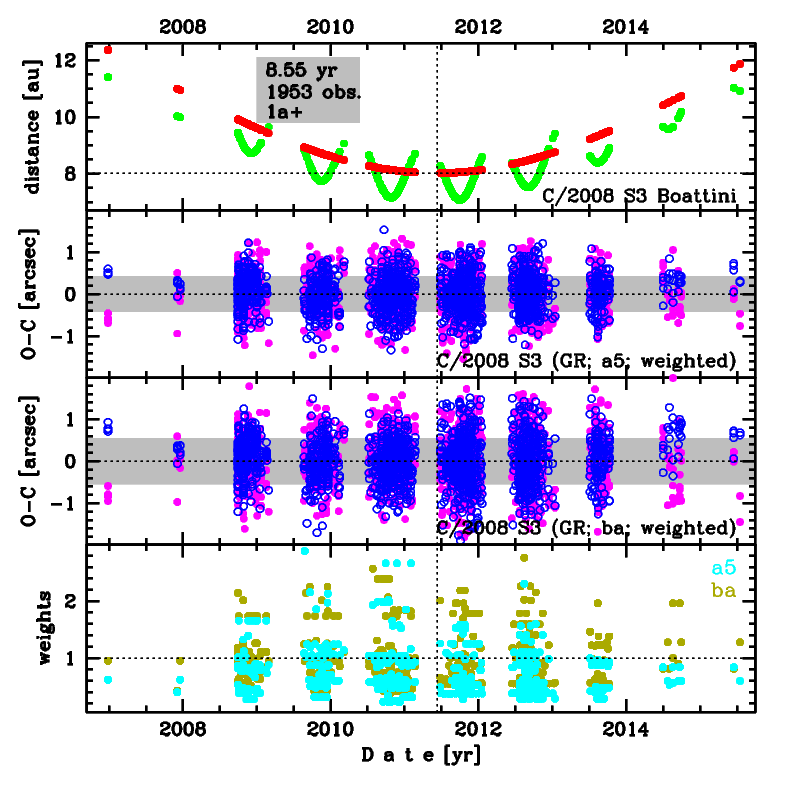C/2008 S3 Boattini
more info
Comet C/2008 S3 was discovered on 29 September 2008, that is 4.5 yr before perihelion passage. Later, three series of pre-discovery measurements were found: from 2007 December 18 (Mt Lemmon Survey, 12.4 au from the Sun), 2007 December 4 (Catalina Sky Survey, 11.0 au), and 2006 December 27 (Mt Lemmon Survey, 10.9 au). Each of these series consists of four measurements. Thus, data arc covers 8.6,yr in a heliocentric distance range of 12.4 au – 8.015 au (perihelion) – 11.9 au.
Comet had its closest approach to the Earth on 30 September 2011 (7.075 au, almost four months after perihelion).
This Oort spike comet suffers tiny planetary perturbations during its passage through the planetary system.
See also Królikowska and Dones 2023 and Królikowska and Dybczyński 2017.
Comet had its closest approach to the Earth on 30 September 2011 (7.075 au, almost four months after perihelion).
This Oort spike comet suffers tiny planetary perturbations during its passage through the planetary system.
See also Królikowska and Dones 2023 and Królikowska and Dybczyński 2017.
| solution description | ||
|---|---|---|
| number of observations | 1953 | |
| data interval | 2006 12 27 – 2015 07 17 | |
| data type | perihelion within the observation arc (FULL) | |
| data arc selection | entire data set (STD) | |
| range of heliocentric distances | 12.36 au – 8.02 au (perihelion) – 11.87 au | |
| detectability of NG effects in the comet's motion | NG effects not determinable | |
| type of model of motion | GR - gravitational orbit | |
| data weighting | YES | |
| number of residuals | 3888 | |
| RMS [arcseconds] | 0.42 | |
| orbit quality class | 1a+ | |
| orbital elements (heliocentric ecliptic J2000) | ||
|---|---|---|
| Epoch | 2006 06 27 | |
| perihelion date | 2011 06 03.77078156 | ± 0.00041465 |
| perihelion distance [au] | 8.01530277 | ± 0.00000267 |
| eccentricity | 1.00360318 | ± 0.00000250 |
| argument of perihelion [°] | 39.796141 | ± 0.000025 |
| ascending node [°] | 54.922655 | ± 0.000012 |
| inclination [°] | 162.717969 | ± 0.000005 |
| reciprocal semi-major axis [10-6 au-1] | -449.54 | ± 0.31 |

Upper panel: Time distribution of positional observations with corresponding heliocentric (red curve) and geocentric (green curve) distance at which they were taken. The horizontal dotted line shows the perihelion distance for a given comet whereas vertical dotted line — the moment of perihelion passage.
Middle panel(s): O-C diagram for a given solution (sometimes in comparison to another solution available in CODE), where residuals in right ascension are shown using magenta dots and in declination by blue open circles.
Lowest panel: Relative weights for a given data set(s).
Middle panel(s): O-C diagram for a given solution (sometimes in comparison to another solution available in CODE), where residuals in right ascension are shown using magenta dots and in declination by blue open circles.
Lowest panel: Relative weights for a given data set(s).